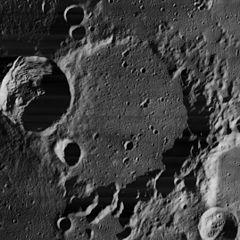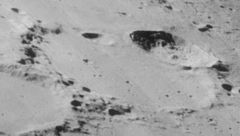 Lunar Orbiter 4 image of Goldschmidt, also showing Anaxagoras at left | |
| Coordinates | 73°00′N 3°48′W / 73.0°N 3.8°W |
|---|---|
| Diameter | 113 km |
| Depth | 2.0 km |
| Colongitude | 3° at sunrise |
| Eponym | Hermann Goldschmidt |
Goldschmidt is a large lunar impact crater of the variety commonly termed a walled plain. It lies in the northern part of the Moon's near side, and appears oval in shape due to foreshortening. The rim is actually relatively circular, although the western rim is overlain by the prominent crater Anaxagoras. Nearly attached to the southeast rim is Barrow, and the two formations are separated by a rugged rise about 30 kilometers across. Further to the south is Epigenes.
The heavily eroded outer rim of Goldschmidt is rugged and irregular, with an inner wall that is incised in several locations by small impacts. Much of the western rim no longer exists, due to the overlapping Anaxagoras and the smaller Anaxagoras A, and the ejecta from these formations covers the western third of the interior floor. The remaining floor is nearly level and flat, most likely having been resurfaced by lava flows. However the surface is now pock-marked by a multitude of tiny craterlets, the most prominent being the small Goldschmidt A.
Satellite craters
By convention these features are identified on lunar maps by placing the letter on the side of the crater midpoint that is closest to Goldschmidt.
| Goldschmidt | Latitude | Longitude | Diameter |
|---|---|---|---|
| A | 72.5° N | 2.5° W | 7 km |
| B | 70.6° N | 6.7° W | 10 km |
| C | 71.1° N | 6.0° W | 7 km |
| D | 75.3° N | 7.7° W | 14 km |
References
- Andersson, L. E.; Whitaker, E. A. (1982). NASA Catalogue of Lunar Nomenclature. NASA RP-1097.
- Blue, Jennifer (July 25, 2007). "Gazetteer of Planetary Nomenclature". USGS. Retrieved 2007-08-05.
- Bussey, B.; Spudis, P. (2004). The Clementine Atlas of the Moon. New York: Cambridge University Press. ISBN 978-0-521-81528-4.
- Cocks, Elijah E.; Cocks, Josiah C. (1995). Who's Who on the Moon: A Biographical Dictionary of Lunar Nomenclature. Tudor Publishers. ISBN 978-0-936389-27-1.
- McDowell, Jonathan (July 15, 2007). "Lunar Nomenclature". Jonathan's Space Report. Retrieved 2007-10-24.
- Menzel, D. H.; Minnaert, M.; Levin, B.; Dollfus, A.; Bell, B. (1971). "Report on Lunar Nomenclature by the Working Group of Commission 17 of the IAU". Space Science Reviews. 12 (2): 136–186. Bibcode:1971SSRv...12..136M. doi:10.1007/BF00171763.
- Moore, Patrick (2001). On the Moon. Sterling Publishing Co. ISBN 978-0-304-35469-6.
- Price, Fred W. (1988). The Moon Observer's Handbook. Cambridge University Press. ISBN 978-0-521-33500-3.
- Rükl, Antonín (1990). Atlas of the Moon. Kalmbach Books. ISBN 978-0-913135-17-4.
- Webb, Rev. T. W. (1962). Celestial Objects for Common Telescopes (6th revised ed.). Dover. ISBN 978-0-486-20917-3.
- Whitaker, Ewen A. (1999). Mapping and Naming the Moon. Cambridge University Press. ISBN 978-0-521-62248-6.
- Wlasuk, Peter T. (2000). Observing the Moon. Springer. ISBN 978-1-85233-193-1.
